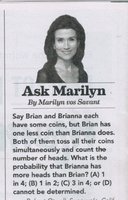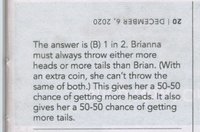LCKurtz
Full Member
- Joined
- May 3, 2019
- Messages
- 475
Here's an image of the question:

And here's her answer in spoiler tags if you want to think about it first:
My reason for posting is that I don't think her "solution" is valid although, surprisingly to me at least, the answer is apparently correct. I think the particular answer depends crucially on the fact that one set of coins is exactly 1 larger than the other, whereas I think her "solution" applies equally well where the numbers of coins differ by more than 1, and where she would get a wrong answer. It's wrong for 4 vs. 2 coins and dramatically worse for larger differences. And a proper solution looks to me to involve some identities with binomial coefficients that don't look trivial to me. What do you think?

And here's her answer in spoiler tags if you want to think about it first:
My reason for posting is that I don't think her "solution" is valid although, surprisingly to me at least, the answer is apparently correct. I think the particular answer depends crucially on the fact that one set of coins is exactly 1 larger than the other, whereas I think her "solution" applies equally well where the numbers of coins differ by more than 1, and where she would get a wrong answer. It's wrong for 4 vs. 2 coins and dramatically worse for larger differences. And a proper solution looks to me to involve some identities with binomial coefficients that don't look trivial to me. What do you think?

